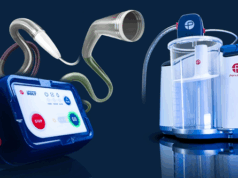 InterVene announced today that the first patient has been treated with its Recana thrombectomy catheter system for venous in-stent restenosis (ISR).
InterVene announced today that the first patient has been treated with its Recana thrombectomy catheter system for venous in-stent restenosis (ISR).
The company shares in a press release that Recana is the first fully integrated mechanical thrombectomy system designed specifically to address the long-term complications of venous disease, including ISR and native vein obstructions. The case was performed at University Hospital Galway in Galway, Ireland, by interventional radiologist Gerry O’Sullivan.
“The long-term sequelae of venous obstructions, whether in-stent or native vessel, are a devastating consequence of deep venous thrombotic disease. There remains a considerable gap in effective interventional treatments for physicians and their patients living with persistent symptoms related to venous outflow obstructions,” said O’Sullivan. “I had previously tried and failed to recanalise this patient’s vessels on four separate occasions—Recana succeeded in just one. This technology offers real promise for patients with limited treatment options.”
The case was a result of collaboration between InterVene and the University of Galway Institute of Clinical Trials. “We are proud to see Recana become one of the first innovations to enter clinical use in Ireland through the Hypercare initiative,” said Fidelma Dunne, director of the Institute for Clinical Trials at the University of Galway. “This first-in-human procedure reflects Hypercare’s core mission to streamline the clinical trial process and accelerate patient access to breakthrough therapies.”
“This successful first-in-human procedure comes after several years of rigorous work to prove a transformative design to address a major unmet need in venous disease,” stated Jeff Elkins, chief executive officer of InterVene. “We are proud to support Dr O’Sullivan in caring for patients suffering from the life-limiting effects of ISR. Completing this first case marks an important milestone in bringing our technology to patients affected by the long-term complications of venous disease.”








